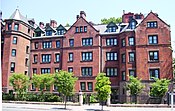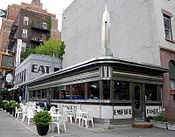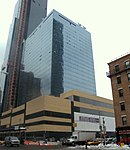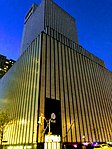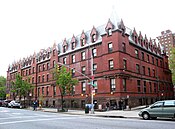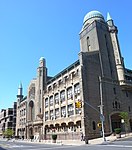Tenth Avenue (Manhattan)
| Amsterdam Avenue (north of West Street | |
| North end | Fort George Avenue |
|---|---|
| East | Ninth Avenue (below 59th St) Columbus Avenue (above 59th St) |
| West | Eleventh Avenue (below 59th St) West End Avenue (above 59th St) |
| Construction | |
| Commissioned | March 1811 |

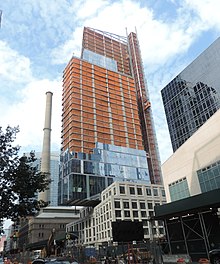
Tenth Avenue, known as Amsterdam Avenue between 59th Street and 193rd Street, is a north-south thoroughfare on the West Side of Manhattan in New York City. It carries uptown (northbound) traffic as far as West 110th Street (also known as Cathedral Parkway), after which it continues as a two-way street.
Geography
Tenth Avenue begins a block below
As Amsterdam Avenue, the thoroughfare stretches 129 blocks north – narrowing to one lane in each direction as it passes through
On the north side of Highbridge Park, unconnected to Amsterdam Avenue on the south side, Tenth Avenue then runs for slightly less than a mile from the northern terminus of the
History
Tenth Avenue runs through the
The
Public debate about the hazard began during the early 1900s.[11] In 1929, the city, the state, and New York Central agreed on the West Side Improvement Project,[12] conceived by Robert Moses.[13] The 13-mile (21 km) project eliminated 105 street-level railroad crossings and added 32 acres (13 ha) to Riverside Park; it also included construction of the West Side Elevated Highway. It cost more than $150 million (about $2 billion in 2017 dollars).[14]
The part of Tenth Avenue north of West 59th Street was renamed "Amsterdam Avenue" in 1890 at the request of local merchants seeking to distance themselves from "Death Avenue" and to increase the value of their properties in an area that had yet to "catch on".
The Fort George Amusement Park, now a seating area in Highbridge Park, was located at the northern end of Amsterdam Avenue from 1895 to 1914.[18]
Tenth Avenue and Amsterdam Avenue were converted to carry one-way traffic northbound in two stages. South of its intersection with Broadway, the avenue was converted on November 6, 1948.[19][20] The remainder, to 110th Street, was converted on December 6, 1951.[21] Amsterdam Avenue continues to carry two-way traffic north of 110th Street.
During the real estate boom of the late 20th century, Amsterdam Avenue from roughly 59th Street to 96th Street became one of the city's most expensive residential districts.
Transportation
The
As part of the
A
Notable sites
- Cathedral of St. John the Divine
- Chelsea Market
- The Chitte Building
- City College of New York
- Columbia University
- Empire Diner
- General Theological Seminary
- High Line Park
- Hudson Yards Redevelopment Project
- John Jay College
- LaGuardia High School
- Lincoln Center for the Performing Arts
- Manhattan Plaza
- Martin Luther King Jr. Educational Campus
- MiMA
- NewYork–Presbyterian Hospital
- Sherman Square
- Mount Sinai Morningside
- Verdi Square
- West-Park Presbyterian Church
- Yeshiva University
Gallery
-
The Desmond Tutu Center of the General Theological Seminary at 20th–21st Streets
-
The Empire Diner at 22nd Street
-
An AT&T building at 811 10th Avenue, at the corner of W. 53rd St.
-
The interior of theHoly Name of Jesus Roman Catholic Churchat 96th Street
-
TheAmerican Youth Hostelsbuilding at 103rd Street
-
The Cathedral of St. John the Divine at 110th Street
-
The formerNYPD32nd Precinct building on Amsterdam Avenue at 152nd Street
-
TheHighbridge Play Centerat 173rd Street
-
Zysman Hall of Yeshiva University, at 187th Street
In popular culture
- The Rodgers and Hart play On Your Toes (1936) included the comic dance number "Slaughter on Tenth Avenue", performed by Ray Bolger and Tamara Geva. It was later performed on stage, film and television. It has been performed by the New York City Ballet, and was featured in the film version of On Your Toes, danced by Eddie Albert and Vera Zorina. In the biographical musical Words and Music (1948), a "Slaughter on Tenth Avenue" ballet sequence is performed by Gene Kelly and Vera-Ellen.
- The Girl from 10th Avenue is the name of a 1935 dramatic film starring Bette Davis.
- Slaughter on Tenth Avenue is also the name of a 1957 crime film and the debut album of Mick Ronson in 1974.
- In Moscow on the Hudson (1984), Robin Williams's character Vladimir Ivanoff lived on 1320 Amsterdam Avenue.
- In How I Met Your Mother, Ted Mosby is said to have lived near the corner of 75th Street and Amsterdam Avenue.
- In Donald E. Westlake's "Dortmunder" series of crime novels, the fictional O.J. Bar and Grill (the gang's favorite meeting place) is located on Amsterdam Avenue.
- In the "Suits, Mike Ross mentions renting an apartment "off 10th Avenue", to which his colleague Rachel Zane replies, "Does it come with a bullet-proof vest?".
- Amsterdam Avenue is mentioned in the Joe Jackson song "Stranger Than You", from the album Night and Day II.
References
- ^ Google (December 1, 2015). "Tenth Avenue / Amsterdam Avenue" (Map). Google Maps. Google. Retrieved December 1, 2015.
- ^ Meyer, David (June 21, 2018). "Safer Bikeways Slated for Columbus Circle and Amsterdam Avenue". StreetsBlog. Archived from the original on July 17, 2019.
On 10th Avenue/Amsterdam Avenue — the street name shifts at 59th Street — DOT plans to extend the protected bike lane design it installed between 72nd Street and 110th Street two years ago.
- ^ Meyer, David (October 16, 2018). "OUTRAGE! DOT Delays Life-Saving Amsterdam Avenue Redesign in Fight With NIMBYs". StreetsBlog. Archived from the original on July 17, 2019.
Thompson spoke to Streetsblog after the meeting, where she and the board's Vice Chairman Victor Edwards opposed the traffic-calming plan, which is not even as complete as the improvements made to one-way Amsterdam Avenue below 110th Street. Indeed, instead of a protected bike lane, the plan for the two-way stretch from 110th Street to 162nd Street would install unprotected lanes, painted medians, and turn lanes in both directions.
- ^ Robbins, L.H. (June 3, 1934). "Transforming the West Side: A Huge Project Marches On". The New York Times. Retrieved July 17, 2019.
- ^ Hudson River and the Hudson River Rail-Road. Boston: Bradbury & Guild. 1851. p. 12. Retrieved September 18, 2015.
- ^ Highline Photo of the Week West Side Cowboy
- ^ "High Line History". Friends of the High Line. Archived from the original on September 22, 2014.
- ^ a b Amateau, Albert (April 30, 2008). "Newspaper was there at High Line's birth and now its rebirth". The Villager. Vol. 77, no. 48. Archived from the original on July 13, 2011.
- ^ Gray, Christopher (December 22, 2011). "When a Monster Plied the West Side". The New York Times. Archived from the original on May 17, 2014. Retrieved May 12, 2014.
The New York World referred to the West Side route as Death Avenue in 1892, long after the Park Avenue problem had been solved, saying 'many had been sacrificed' to 'a monster which has menaced them night and day.'
- ISSN 0362-4331. Retrieved February 12, 2018.
- ISSN 0362-4331. Retrieved February 12, 2018.
- ^ "The Highline: past and present". GeoWeb, Harvard University. May 13, 2010. Archived from the original on October 23, 2014. Retrieved October 23, 2014.
- ^ Walsh, Kevin (September 2012). ""High Line"'s Last Frontier". Forgotten NY. Archived from the original on October 24, 2014.
- ^ "High Line History". Friends of the High Line. Archived from the original on September 22, 2014. Retrieved August 2, 2009.
- ISSN 0362-4331. Retrieved July 17, 2019.
- ISBN 978-0-8147-2712-6.
- ISBN 978-0-8232-1275-0.
- ^ Martens, Victoria (August 1, 2019). "Fort George Amusement Park". Museum of the City of New York. Retrieved September 2, 2019.
- ^ Ingraham, Joseph (7 November 1948). "Traffic Speeded on 9th, 10th Aves. By One-way Plan". The New York Times. Retrieved 28 August 2012.
- ^ "Ninth and Tenth Avenues Are One Way Permanently". The New York Times. 14 May 1949. Retrieved 28 August 2012.
- ^ "Two More Avenues One-way Thursday". The New York Times. 4 December 1951. Retrieved 28 August 2012.
- ^ "Manhattan Bus Map" (PDF). Metropolitan Transportation Authority. July 2019. Retrieved December 1, 2020.
- ^ *Fitzsimmons, Emma G. (September 10, 2015). "Subway Station for 7 Line Opens on Far West Side". The New York Times. Retrieved September 13, 2015.
- "New 7 line subway extension to the West Side opens". ABC7 New York. September 13, 2015. Retrieved September 13, 2015.
- Tangel, Andrew (September 13, 2015). "New Subway Station Opens on NYC's Far West Side". WSJ. Retrieved September 13, 2015.
- "Photos: NYC's Newest (And 469th) Subway Station, 34th Street-Hudson Yards, Is Open". Gothamist. September 13, 2015. Archived from the original on September 15, 2015. Retrieved September 13, 2015.
- ^ Chan, Sewell; Bagli, Charles V. (April 2, 2005). "M.T.A. Links Stadium Bid to Rail Extension". The New York Times.
- ^ Neuman, William (September 19, 2008). "No. 7 Extension Won't Include 10th Ave. Station". The New York Times.
- ^ "Subway Map" (PDF). Metropolitan Transportation Authority. September 2021. Retrieved September 17, 2021.
- ^ Meyer, David (May 20, 2016). "Eyes on the Street: First Signs of Amsterdam Avenue's Protected Bike Lane". StreetsBlog. Archived from the original on July 17, 2019.
- ^ Garofalo, Michael (June 26, 2018). "DOT plans new UWS bike lanes". West Side Spirit. Archived from the original on July 17, 2019.
The protected lane would continue past 59th Street, where 10th Avenue becomes Amsterdam Avenue, and connect to the existing protected bike lane on Amsterdam Avenue that begins at 72nd Street and runs to 110th Street.
- ^ Carlin, Dave (August 29, 2023). "New bicycle lane on 10th Avenue to be among widest in Manhattan, and it already has New Yorkers taking sides". CBS New York. Retrieved September 1, 2023.
- ^ Brachfeld, Ben (August 23, 2023). "10th Avenue build out: DOT set to create protected bike lane on Midtown/Hell's Kitchen thoroughfare". amNewYork. Retrieved September 1, 2023.
External links
 Media related to 10th Avenue (Manhattan) at Wikimedia Commons
Media related to 10th Avenue (Manhattan) at Wikimedia Commons

